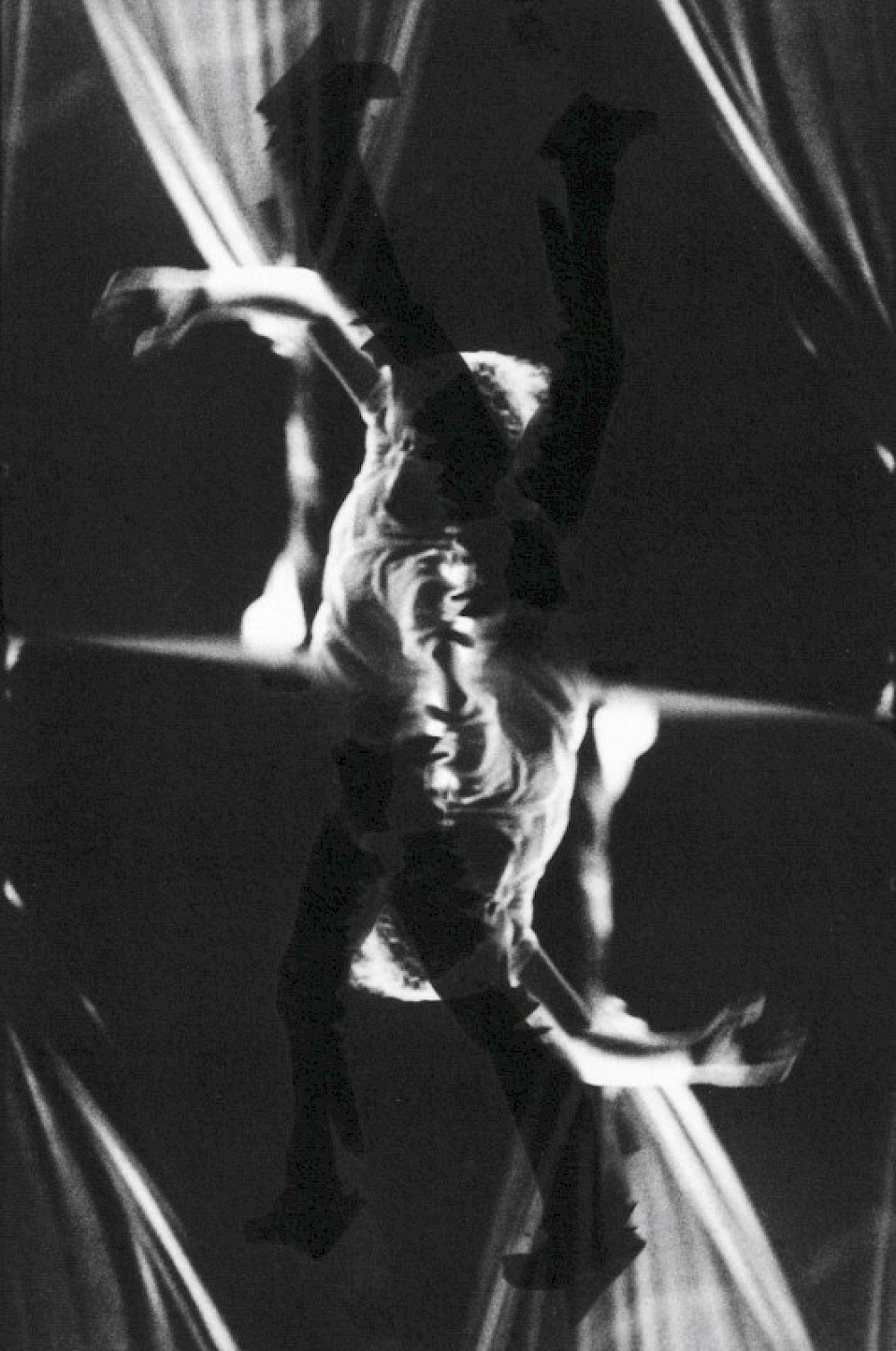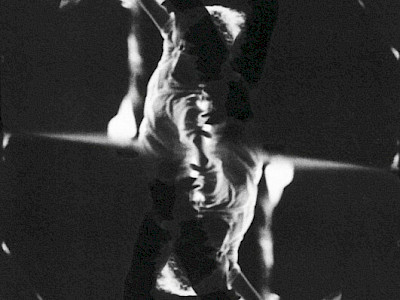20 — 23.05.2010
The Brussels-based French choreographer Etienne Guilloteau is developing an oeuvre centred on the relation between dance, music and light. In Tres Scripturae, a creation for three dancers, a musician and a technician, he brings these distinct scripts into dialogue with one another. In his essay on Bunraku, Les Trois Écritures, semiotician Roland Barthes argues that this form of Japanese puppet theatre, by using a separate script for the puppets, the puppeteers and the narrator, sets itself against the dualistic metaphysics of Western theatre. Guilloteau assigns the performance area to both lighting designer Hans Meijer, who openly manipulates the light and space, and pianist Alain Franco, who performs scores from the twentieth-century repertoire. By thus revealing the elements upholding the performance, Tres Scripturae triggers the audience’s active involvement. With Tres Scripturae, Etienne Guilloteau has created an open space between illusion and deconstruction, intelligence and abstraction – a space in which spectators can give free rein to their sensibility and imagination. A revelation!
Tres Scripturae
The name of the piece, Tres Scripturae, means “three writings” and makes reference to the three lines of writing at work in the piece: the choreographic writing, the musical writing and the stage writing (set and lighting).
We start with simple elements and then divide, multiply and deconstruct them in a movement tending towards the baroque. This is done in order to discover and reveal part of what they are hiding which is not yet, or not always, visible.
The dance
The choreographic material has been created with Claire Croizé and Claire Godsmark. Dance is one of the constituent elements of theatre, but is also distinct from it and has its own codes beyond the place where it is performed. We started with simple, almost immobile forms for the body. These few movements also featured in my earlier piece, La Magnificenza, and then only for a few seconds of the show. We are trying to see how movement can explore and reveal several approaches to architectures and images through a work comprising various rhythmical compositions, transformations of qualities and arrangements of space. The material is taut/relaxed, contracted/dilated, enveloped/developed, shrinking and evolving. What we do is show how this simple body becomes a multitude of bodies and images by opening out through the composition. The principles (rules of composition) which act on this body, like pressure points, make it bend and turn it into an “expressive form” which is interpreted by the memory of each person to become an evocative composition awakening our sensibility. This comes from images suggestive of classical painting, sculpture from topical images or quite simple, everyday gestures. These images are only differentiated at times by tiny details: a different quality, a slight twisting, an extended hold… Our intention is not to produce these performances in a graphic exactitude of what they suggest, but rather to leave them to appear like a remote event that could be evoked and with some of the details removed. So each person’s memory is triggered and determines what is being represented.
The music
The choices of music have been made with the pianist and conductor Alain Franco.
Music is the second element in this piece. Here too we started with simple construction principles used by several composers and created links between them. Sometimes they have taken the same routes, creating analogies between the works that we use as bridges or crossroads to move through the different pieces. Our attention is initially given predominantly to 20th century composers to locate us in contemporary music, but also because the notion of ensemble and dynamics is dominant here. However it would be unsurprising if some musical pieces take us to other times and places of musical creation.
The choice of music has been determined as the project is being created in order to respond most closely to the requirements of the piece which demands a clarity in movement of all the lines of writing that comprise the performance. The music is performed on the piano by Alain Franco who is also an actor in the piece. Beyond the undeniable quality of having a live performance, the presence of the musician on stage is also necessary to personify the musical writing and is part of the idea of an action in the process of being performed, with its frailties and strengths, in order to locate all the elements that make up the piece irremediably in the present.
The theatre
The lighting has been created with the lighting designer Hans Meijer.
In these simple elements, there is also the theatre as a performance space as well as items related to how it functions (legs, tubes, lights etc.). This place can be perceived and apprehended as a world in itself, but through its function and history it is also a place that favours the production of allegories of a bigger and more complex exterior world. The space itself, thanks to the lighting, can contain a multitude of impressions and feelings while remaining a brick wall. The lighting is used to reveal the different layers found in it at the time of the performance. Like a camera lens, it allows us to take stock of the different elements making up the performance. For example, almost soulless flat working lights reinforce the immediacy of the performance and accentuate the fact that we are performers in the middle of producing a piece where we are only representing ourselves in the process of acting. The lights present a raw reality without artifice which goes to magnify the performance.
Another light is used to dramatise the performance and no longer illuminates the space in an objective way but “characterises” or colours (in the figurative sense) everything that is being performed in order to reveal another aspect of it. All these elements are manipulated within the spectator’s view without trying to create the kind of illusion that an obscure mechanism could produce. We want the “hand” that modifies them to be visible to show the image and its construction mechanism simultaneously. After all, the theatre is only a box dedicated to a game being constructed/deconstructed and we wish to establish a transparent arrangement to do away with the mystery and just leave the act of making the impression.
These three elements (dance, music and theatrical objects) are therefore enveloped in the performance venue which becomes a world in itself. No one has a prerogative over the others but they are confronted in different relationships.
They are juxtaposed in a place of affinity where nature has put them: the theatre. They can come together in a strange twinship and agree with, accommodate or oppose one another. This proximity produces relationships between things, the lighting, the people and the music. They share the same space and therefore a similarity through the link they have with the place they occupy and are participating in the same movement which is the performance. It is in these different relationships that all the ingredients of theatre intersect, overlap or move away and establish links and equilibrium between the noticeable and the abstract.
The piece is not an object being shown, but rather an act we are witnessing. The manipulations are not hidden from the spectator; they are used completely transparently so that the aesthetics do not swamp what is being seen but allow it to participate in the construction and deconstruction of the elements that make up the piece.
All this in the hope that the exhibition of this mechanism is a space of freedom for what is seen and for interpretation and the imagination.
March 2010
Artistic direction
Etienne Guilloteau
With
Claire Croizé, Claire Godsmark, Etienne Guilloteau, Alain Franco, Hans Meijer
Piano
Alain Franco
Light design
Hans Meijer
Administration
Karolien Derwael
Production manager
Katleen Gils
Presentation
Kunstenfestivaldesarts,
La Raffinerie
Production
Action Scénique vzw (Antwerp)
Coproduction
Kunstenfestivaldesarts, WorkspaceBrussels (Brussels), Monty (Antwerp)
In collaboration with
Buda (Kortrijk), Wp Zimmer (Antwerp), Les Brigittines (Brussels), Piano’s Maene
With the support of
Vlaamse Overheid, Vlaamse Gemeenschapscommissie, Buda (Kortrijk), Wp Zimmer (Antwerp), Les Brigittines (Brussels)


